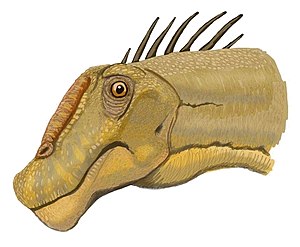Nemegtosaurus
| Nemegtosaurus | ||||||||||
|---|---|---|---|---|---|---|---|---|---|---|

Reconstruction of the head of Nemegtosaurus |
||||||||||
| Temporal occurrence | ||||||||||
| Upper Cretaceous (early Maastrichtian ) | ||||||||||
| 72 to 69.9 million years | ||||||||||
| Locations | ||||||||||
|
||||||||||
| Systematics | ||||||||||
|
||||||||||
| Scientific name | ||||||||||
| Nemegtosaurus | ||||||||||
| Nowinski , 1971 | ||||||||||
| species | ||||||||||
|
Nemegtosaurus is a sauropod dinosaur from the Titanosauria group that lived in the Upper Cretaceous in what is now Mongolia . This species is known from a nearly complete skull from the early Maastrichtian of Nemegt formation recovered and as Nemegtosaurus mongoliensis (1971 Nowinski) described was.
The family relationships of Nemegtosaurus have long been controversial. It was originally considered a sauropod similar to Dicraeosaurus and was classified within the Diplodocoidea - further studies postulated a position as a sister taxon of the Diplodocoidea. More recent studies believe in a position within the Titanosauria, which was confirmed in a new description of the find by Wilson (2005).
The dinosaur fauna of the Late Cretaceous Mongolia is known for numerous finds of bird basin dinosaurs and theropods , which mainly come from the Barun-Goyot Formation and the Djadochta Formation - Protoceratops , Velociraptor and Tarbosaurus , for example . Sauropods are rarer in this fauna, so only two other finds from the Nemegt formation are known: Quaesitosaurus and Opisthocoelicaudia . Quaesitosaurus is known for its incomplete skull and is closely related to Nemegtosaurus , while Opisthocoelicaudia is based on a skullless skeleton. These finds, along with the Nemegtosaurus skull, are among the best preserved sauropod fossils from the Late Cretaceous Laurasia (the northern land masses).
Find and research history
The type material (holotype) of Nemegtosaurus mongoliensis consists of a compressed, but almost complete skull (including articulated lower jaw), which is only missing parts of the upper side (nasal region). Originally the find consisted of a single block, but it was broken into four parts after taxidermists removed almost all of the surrounding rock.
So far there have been three attempts at reconstruction (Nowinski, 1971, Salgado and Calvo, 1997, and Wilson, 2005), but some of them contradict each other. According to Wilson (2005), the skull was clearly similar to that of Rapetosaurus . The nostrils were enlarged and slanted above the teardrop-shaped orbital windows , the latter have ornaments on the upper edge. The skull is elongated and its top slopes down towards the front. The total of about 52 teeth are thin-crowned and pin-shaped, similar to those of the Diplodocoidea - Nemegtosaurus and other titanosaurs show that thin-crowned teeth have developed independently of one another at least twice in the evolution of the sauropods. The jaws show a continuous change of teeth: replacement teeth pushed out worn teeth to be replaced from below, replacement teeth seem to have appeared next to the teeth to be replaced in some positions.
Dong (1977) described another species with Nemegtosaurus pachi based on teeth that were discovered in the Turpan Basin in Xinjiang , China. However, this species is considered to be the noun dubium and the assignment to Nemegtosaurus is doubtful. Wilson (2005) notes that the classification as Nemegtosaurus lacks the basis, since the supposed characteristic typical for this genus also occurs in other titanosaurs. Maryanska (2000) mentioned another skull that could possibly belong to Nemegtosaurus , but has not yet been described.
Wilson (1997) suggested that the remains of Nemegtosaurus and those of Quaesitosaurus could belong to the same species - but in his new description (2005) he found differences that justify separate genera. Since no skull material is known from Opisthocoelicaudia , it cannot be ruled out that it is identical to Nemegtosaurus , which Paul (1996) already suspected.
Systematics
Initially, Nemegtosaurus and Quaesitosaurus were classified within the Dicraeosaurinae due to similarities in skull structure and teeth. Upchurch (1995) placed Nemegtosaurus in the new family Nemegtosauridae, which should include all Diplodocoids more closely related to Nemegtosaurus than to Diplodocus . However, Rogers and Forster (2001) and Wilson (2002) came to the conclusion that Nemegtosaurus can be found within the Titanosauria - so Wilson (2005) redefined the Nemegtosauridae as a group of species that are more closely related to Nemegtosaurus than to Saltasaurus . According to Wilson, at least the genera Nemegtosaurus , Quaesitosaurus and Rapetosaurus belong to this family.
The classification of the skulls of Nemegtosaurus and Quaesitosaurus was made difficult by the general rarity of skull material in sauropods. For titanosaurs in particular, only material from the postcranial skeleton (the “residual skeleton” that follows behind the skull) is known to a large extent ; there are currently only three skulls that have been described. The genus Rapetosaurus (Curry Rogers and Forster, 2001) is the only find that shows almost complete skull material in connection with the rest of the skeleton.
literature
Unless otherwise stated, all information comes from the following work:
- Jeffrey A. Wilson: Redescription of the Mongolian Sauropod Nemegtosaurus mongoliensis Nowinski (Dinosauria: Saurischia) and comments on Late Cretaceous Sauropod diversity. In: Journal of Systematic Palaeontology. Vol. 3, No. 3, 2005, ISSN 1477-2019 , pp. 283-318, doi : 10.1017 / S1477201905001628 .
Individual evidence
- ^ Gregory S. Paul : The Princeton Field Guide To Dinosaurs. Princeton University Press, Princeton NJ et al. 2010, ISBN 978-0-691-13720-9 , p. 212, online .
